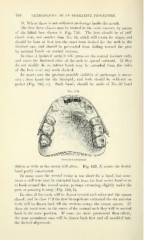Page 766 - My FlipBook
P. 766
764 ORTHODONTIA AS AN OPERATIVE PROCEDURE.
D. Where there is not sufficient anchorage inside the mouth.
The first three classes may be treated in the same manner, by means
of ihe labial bow shown in Fig. 759. The bow should be of stiff
elastic wire, not smaller than No. 16, which will retain its shape, and
shoidd be bent at first into the exact form desired for the arch in the
finished case, and should be prevented from sliding toward the gum
by notched bands on central incisors.
In class A (pointed arch) it will press on the central incisors only,
and cause the flattened sides of the arch to spread outward. If they
do not readily do so, rubber bands may be extended from the sides
of the bow over any teeth desired.
In most cases the greatest possible stability of anchorage is neces-
sary ; then bands for the bicuspid ; and both should be soldered to-
gether (Fig. 760, a). Such bands should be made of No. 30 band
Fi
Increased anchorage.
ribbon as wide as the crown will allow. Fiff. 629, E, shows the double
band partly constructed.
In many cases the second molar is too short for a band, but some-
times a stiff wire may be extended back from the first molar band so as
to hook around the second molar, perhaps extending slightly under the
gum or pressing it away (Fig. 760, 6).
In class B the teeth will be drawn toward each other and the spaces
closed ; and in class C if the first bicuspids are extracted the six anterior
teeth will be drawn back till the canines occupy the vacant spaces. If
these six teeth were in the curve of the normal arch they will be moved
back in the same position. If some are more prominent than others,
the more prominent ones will be drawn back first and all moulded into
the desired alignment.


